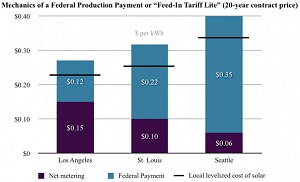New report says solar could be on 100 million roofs and at grid parity by 2021
 By 2021 100 million U.S. residents could have solar on their roofs and be paying less for the electricity provided by those systems than what they can get from the grid. That’s according to the Institute for Local Self-Reliance’s new report, Rooftop Revolution: Changing Everything with Cost-Effective Solar. The report focuses on how U.S. rooftops could house more than 61 gigawatts of solar power that’s at grid parity.
By 2021 100 million U.S. residents could have solar on their roofs and be paying less for the electricity provided by those systems than what they can get from the grid. That’s according to the Institute for Local Self-Reliance’s new report, Rooftop Revolution: Changing Everything with Cost-Effective Solar. The report focuses on how U.S. rooftops could house more than 61 gigawatts of solar power that’s at grid parity.
The report looked at pricing trends for energy and solar and found that they should reach grid parity without incentives by 2021.
“The price trajectory for solar and retail electricity would create 61 GW of [solar] potential at grid parity or better—without including any incentives—by 2021,” said report author and Senior Researcher at the institute John Farrell. “The retail price of electricity rose 2.5 percent per year over the last decade, so I feel that my 2 percent estimate is quite reasonable.”
The report also looked at the trend in decreasing costs of installed solar, which has declined about 10 percent per year, every year, since 2006.
That doesn’t mean the nation should cut off support for solar just yet.
“If the current suite of federal and state incentives were abruptly ended, it could have a profound impact on the solar industry that could disrupt the downward price trajectory,” Farrell said. “The incentives aren't what make the 61 GW of solar economical, but if they aren't modified carefully, they could have ripple effects that change the underlying assumption of the grid-parity analysis.”
To get there, Farrell recommends changing how the U.S. supports solar to get to that level of adoption, including instating a feed-in tariff.
“A feed-in tariff is the best tool to ensure a stable solar market that could enable 100 million Americans to go solar, but other incremental changes could help—lifting aggregate state caps on net metering, shifting to production-based and cash-based incentives, or developing more time-of-use electricity pricing plans,” he said.
Even more solar could be installed on non-residential roofs.
In fact more like 600 gigawatts could be installed on such buildings, according to Farrell.
But whether that power would also be at grid parity is a little more complex since the electric rates used at such facilities are often bought at a lower rate from the grid, but such systems also are costs less to install by up to 25 percent.



